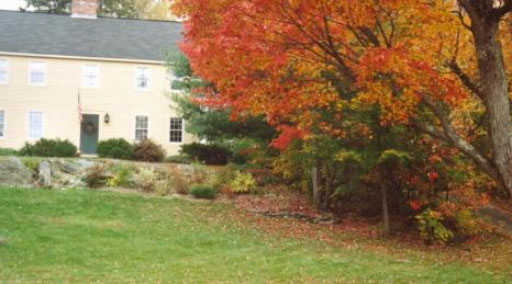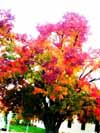20 Tips: Dos & Don'ts for Leaf Peepers
20 ways to be a savvy foliage visitor
 Photograph of Hampden, ME
Photograph of Hampden, ME
Submitted by Harry McCluskey
1. DO get lost. Carry a good map (we like the detailed atlas and gazetteer series by DeLorme mapmakers in Yarmouth, Maine; 800-561-5105; delorme.com) and get a little lost. With 7,401 miles of unpaved roads just in Vermont, there's ample opportunity to find adventure.
2. DO observe proper foliage etiquette. Locals use the back roads to get from here to there as promptly as possible. If you're oohing and ahhing at five miles per hour, pull over when someone's behind you. And DO ask a landowner's permission before tramping into the fields.
3. DO get out of your car, and walk, and smell, and listen. Foliage is the most sensual of New England seasons, from the sweet aromas of our apple orchards to the swirling of leaves and wind, from that first whiff of woodsmoke on a frosty fall day to the crunch of dry foliage underfoot. Seeing foliage is only half the fun. Many of us remember our parents shoving us into the car when we were young and driving for hours with out-of-town relatives. We hated it.
4. DO pick up a parking pass for New Hampshire's White Mountain National Forest to avoid a parking ticket. Funds go to protecting the forest habitat. Best bet is to write or phone ahead for the pass: Fee Demo Program, White Mountain National Forest, 300 Glen Road, Gorham, NH 03581; 603-466-2713. A 12-month pass is $20, $25 for two vehicles in the same family. A one- to seven-consecutive days pass is $5. One-day pass: $3. Seniors are half price. www.fs.fed.us/r9/white
5. DO as professional foliage photographers do when composing photos. A single crimson maple in the foreground with a white church behind and a little blue sky showing will translate better than a 40-mile-distant panoramic view. DON'T forget your polarizing filter. The filter enhances the vivid colors. DO bring lots of film.
6. DO look for changing views. Search out roads with hills and curves, roads that meander through changing vistas of woods and farms and small villages. If there is a better combination than water and stone (stone walls, stone bridges) and autumn leaves, we don't know it.
7. DON'T be a hit-and-run leaf watcher. DON'T rush. A picnic by a waterfall beats dashing all about, hoping to see just one more place before dark.
8. DON'T panic that "peak" is passing you by. Peak color is a continuum, not a moment fixed in time. Within a few miles you'll see different stages, depending on types of trees and elevation. "Seeking peak is missing the point," says Kit Anderson, a Vermont cultural geographer. "It's like condensing the entire season and the entire experience into this one moment, like a sound byte, and people miss it."
9. DO respect "Moose Crossing" signs. Northern New England is moose country. Cars and passengers do not always survive collisions with 1,000-pound moose.
10. DO wake early. The colors will be most vivid with the morning dew and morning light. Watching the dawn mist rise off our forest-ringed lakes and rivers may be the best treat of all.
11. DO linger to enjoy the late-afternoon light. The deep shadows late in the day set off all colors against areas of darkness.
12. DO have lodging reservations during the late September to mid-October prime leaf-watching period. DON'T expect to stay but one night. Most places expect a two-night minimum during foliage.
13. DON'T let your lack of lodging stop your visit. Local Vermont chambers of commerce, for instance, keep a quiet list of hospitable locals who open up that spare room in their homes for intrepid leaf watchers. If possible, DO come midweek.
14. DO look skyward, especially if you're hiking. Mid- to late September is when thousands of broad-winged hawks ride the thermals south. The raptor migration is worthy of a trip in itself.
15. DON'T be a color snob and ignore everything except bright reds. Trees exhibit an astonishing range of colors. Foliage season means subtle shadings of peach and corals and apricot, the subtle yellows of beech and birch, the soft browns and purples. DON'T let rain keep you indoors. Wet weather brings out the most vivid colors.
16. DO go beyond where most people go. Vermonters have a saying: When good people die, they go to Vermont. When good Vermonters die, they go to the Northeast Kingdom -- but relatively few tourists do.
17. DO visit northern Maine for wondrous color with few crowded roads. But DON'T ever think you have the right-of-way when approaching a logging truck on the narrow roads.
18. DO let New Englanders help you find the prime local foliage spots. Best bet for advice: district forest rangers. Many of them are "leaf spotters," asked by the state to report daily and weekly on foliage conditions in their area. Their pride in their home vistas spills over if you stop in at their headquarters and ask where they would go.
19. DO include valleys and the seacoast in your travels. Though most people head to the mountains, in fact the lowland areas boast the brightest and earliest colors. Look for the swamp maples surrounding the marshes.
20. DO visit YankeeFoliage.com often to see color changes on the interactive map of New England, to find driving tours, to submit your digital photos to our foliage photo contest, and lots more!
ONE MORE: View the Foliage Peak Map before planning your trip.





















